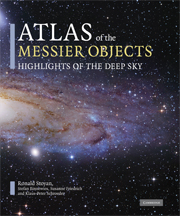Book contents
- Frontmatter
- Dedication
- Contents
- Foreword
- Preface
- User Guide
- Charles Messier
- The Observations
- The Catalog
- Statistics of the Messier objects
- Visual observation of the Messier objects
- Photography of the Messier objects
- The 110 Messier objects
- Glossary of technical terms
- Index of figures
- Index of sources
Foreword
Published online by Cambridge University Press: 05 August 2015
- Frontmatter
- Dedication
- Contents
- Foreword
- Preface
- User Guide
- Charles Messier
- The Observations
- The Catalog
- Statistics of the Messier objects
- Visual observation of the Messier objects
- Photography of the Messier objects
- The 110 Messier objects
- Glossary of technical terms
- Index of figures
- Index of sources
Summary
Why yet another Messier catalog book? With Kenneth Glyn-Jones, Stephen James O'Meara, and Ken Graun, haven't we had enough? No, I say! And especially no when the latest addition to the canon is Ronald Stoyan's scholarly, historical, astrophysical, and superb look at the great comet hunter and the list of objects he compiled during his lifetime.
This book is the first scholarly look at the catalog since Glyn-Jones, and that effort is almost half a century old. Stoyan explores the latest astrophysical research concerning each of Messier's 110 deep sky objects. Stoyan could well devote his entire book to the astrophysics of Messier's first object, the Crab Nebula, and I still subscribe to the belief that I read years ago that astronomy has two parts: that of the Crab and that of everything else. From the first time I looked at M 1 on September 1, 1963, I've been fascinated by the ghostly luminescence of the Crab, but never more so than when it seemed ablaze again not with a new supernova, but with nearby Saturn visiting at nearly the same spot from which the original star first became visible on July 4, 1054.
Next comes the historical view: I cannot get enough of the life of Charles Messier, who lived, observed, searched, and suffered some two hundred years ago. This observer's life story is compelling, and Stoyan's retelling adds new material. Although he was not the first person to discover a comet with a telescope, Messier was most likely the first to organize a successful survey program specifically devoted to the search for comets. For that accomplishment he certainly deserves a place with the greats like William Herschel, Kaoru Ikeya, and Leslie Peltier. In Stoyan's biographical summary we learn a little more about Messier's famous accident, in which he fell into a pit. Although he recovered enough to resume his work, we know for the first time that he never completely got well again, and he finished his life with a continuing limp.
- Type
- Chapter
- Information
- Atlas of the Messier ObjectsHighlights of the Deep Sky, pp. 8Publisher: Cambridge University PressPrint publication year: 2008



